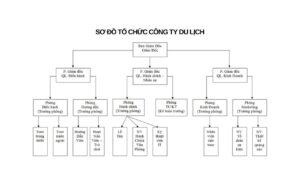In an increasingly competitive business environment, one corporate governance chart Clearly, it plays an extremely important role for businesses to operate effectively and sustainably. It is not only a visual tool to help identify the roles and responsibilities of each department, but also a foundation for optimizing processes, allocating resources and controlling costs.
This article will help you understand clearly What is a corporate governance chart?, importance, common models together 20+ Organizational Chart Templates Reference, suitable for many types of businesses in 2025.
What is a corporate governance chart and why is it important?
Corporate governance chart (or organizational chart) is a visual diagram that describes internal structure of the enterprise, clearly showing departments, positions, roles, responsibilities and reporting relationships between individuals.
Business management diagram provided overview about how businesses are organized and operated.
The corporate governance chart is likened to "operational map" of the company, helping:
- Clearly define the responsibilities and roles of each department and division.
- Avoid overlapping work, optimize coordination efficiency.
- Support decision making, decentralization and transparent control.
- Improve work efficiency, increase scalability.
A clear organizational chart is a solid foundation for cost and financial control. When responsibilities and approval flows are transparent, businesses can easily implement automation solutions such as Bizzi.vn to manage costs and budgets effectively.
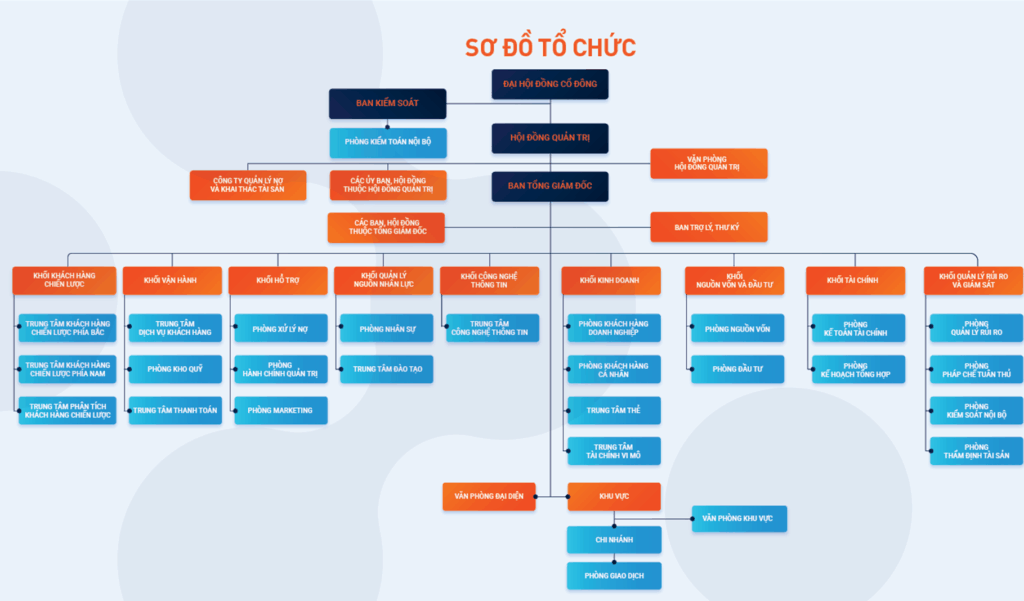
The important role of corporate governance diagram for organizations
One corporate governance chart Not only is it a visual tool to display organizational structure, it also plays a role in shaping strategy, optimizing operations, and helping businesses adapt quickly to change. Below are the core values that organizational charts bring:
1. Show hierarchy and internal structure
Business management diagram provided intuitive approach to present management hierarchy, departments and coordination between departments.
Thanks to that, management and staff easily recognize their position and role in the overall structure. This is an important factor to help avoid the situation overlapping of work and optimize internal coordination efficiency.
2. Support employees to clearly understand their tasks and development roadmap
A clear diagram helps employees define roles of its own in the operating system, clearly understand the assigned tasks, and visualize career development roadmap.
This not only boosts morale but also contributes to retaining talent, especially in businesses that are expanding.
3. Manage contact information effectively
When human resource information is stored centrally on the organizational chart, businesses can:
- Look up information fast and accurate
- Minimize errors when allocating work or communicating internally.
- Create a foundation for the human resource management software effective operations
This is especially useful for companies with multiple locations or remote teams.
4. Enhance management and decision-making efficiency
Corporate governance charts support management in operations. assignment of tasks, monitoring work performance and organizational structure assessment.
A transparent system helps make decisions faster, while ensuring fairness and clear accountability among management levels.
5. Support the entire organization to understand the process and adapt to change
The governance chart acts as a "operational map", clearly described:
- Workflow between parts.
- Approval flow in internal operations.
- Changes in strategy or personnel.
Thanks to that, employees can timely updates and adapt quickly with any changes, thereby reducing operational risks.
Clearly defining responsibilities and approval flow in the organizational chart is prerequisites to implement automated cost management systems such as Bizzi Expense.
This ensures:
- All expenditure all have specific responsible person.
- Budget Compliance has been allocated.
- Make the entire financial process transparent, reduce loss and optimize costs.
Free experience Bizzi.vn to explore cost management automation solutions: Sign up for a trial
The most popular corporate organization chart models
The choice company organization chart model Appropriate is an important step in the process of building an effective operating system. Each model will have features, advantages and limitations separately, suitable for each scale and development orientation of the business. Below are the 5 most popular business management diagram models today:
1. Hierarchy / Traditional Organizational Chart
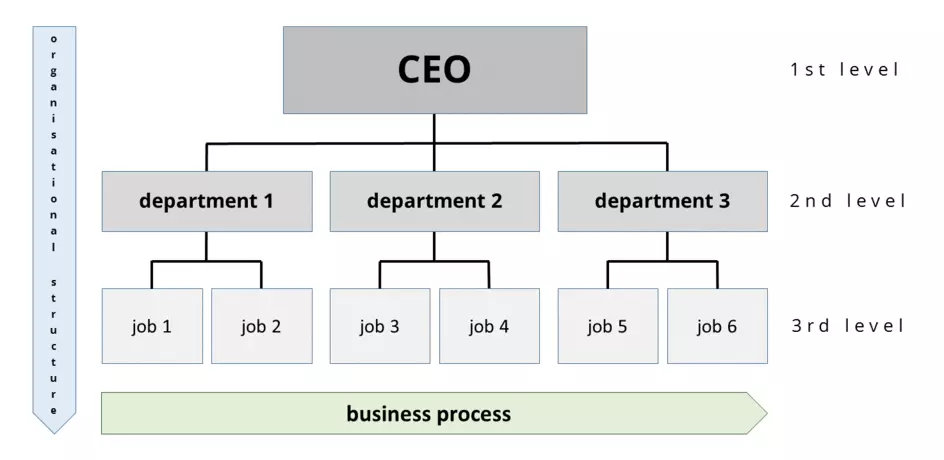
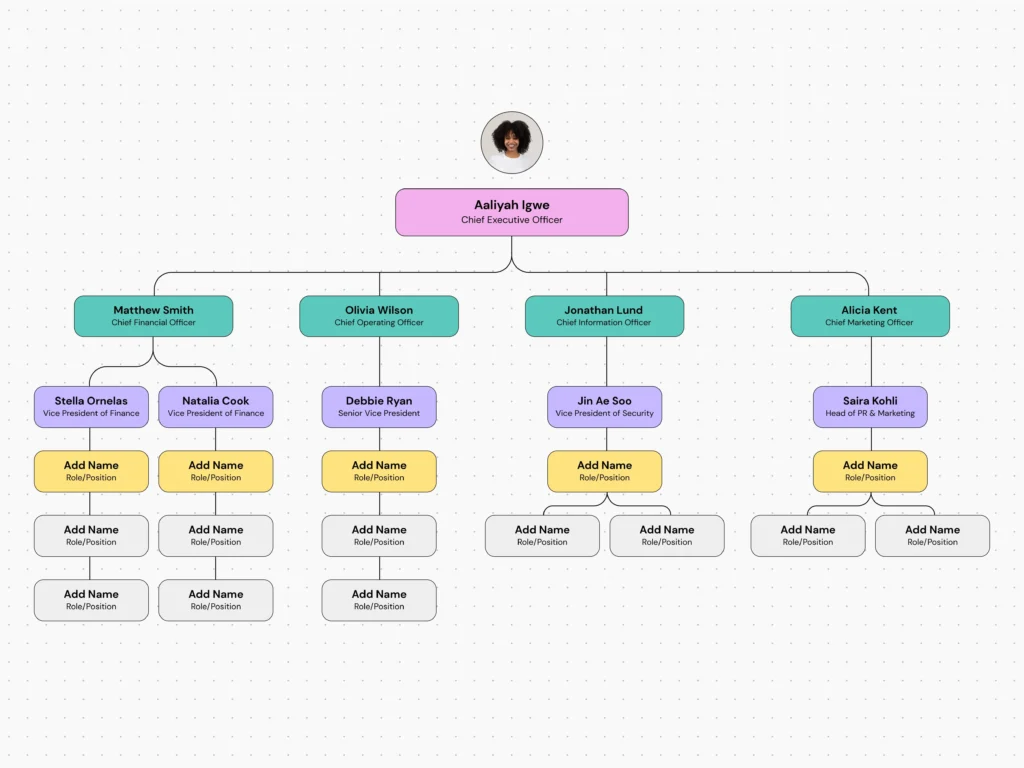
Characteristic:
- This is the traditional model, which shows a clear hierarchy from top management arrive lowest-level employee.
- Each individual has only a direct superior to report work.
Advantage:
- Delimitation clear responsibilities and authorities, easy to manage.
- Route transparent promotion, promote personal growth motivation.
- Highly specialized, optimize the operating efficiency of each part.
Limit:
- Decision making process slow, especially in large organizations.
- Communication gap between managers and employees.
- Lack Flexibility when the market changes rapidly.
Suitable for: Traditional enterprises with stable structures such as banks, government agencies, and large corporations.
2. Functional organization chart
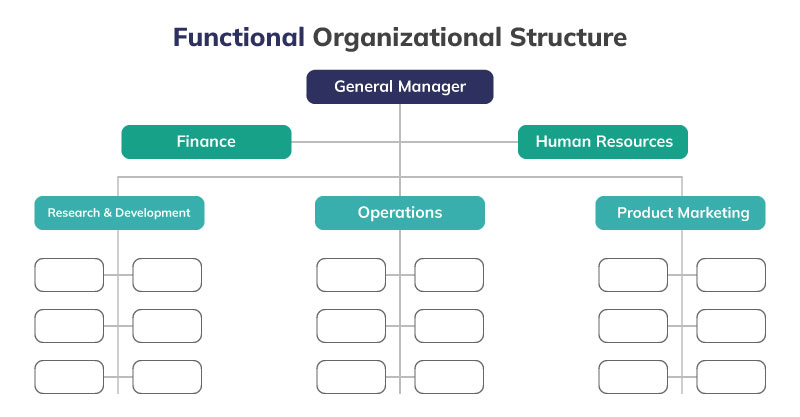
Characteristic:
- Personnel are divided according to main function such as: production, marketing, finance, human resources, sales...
- Each part has professional head.
Advantage:
- Focus on deep expertise, improve productivity and efficiency in each area.
- Help businesses reduce costs by optimizing resources in each department.
Limit:
- Cause difficulties in inter-departmental coordination.
- Easy to form communication barrier causing groups to operate in disarray.
- Difficulty adapting to rapid changes in the market.
Suitable for: Small and medium-sized enterprises, or organizations that focus on optimizing each department's expertise.
3. Matrix organization model
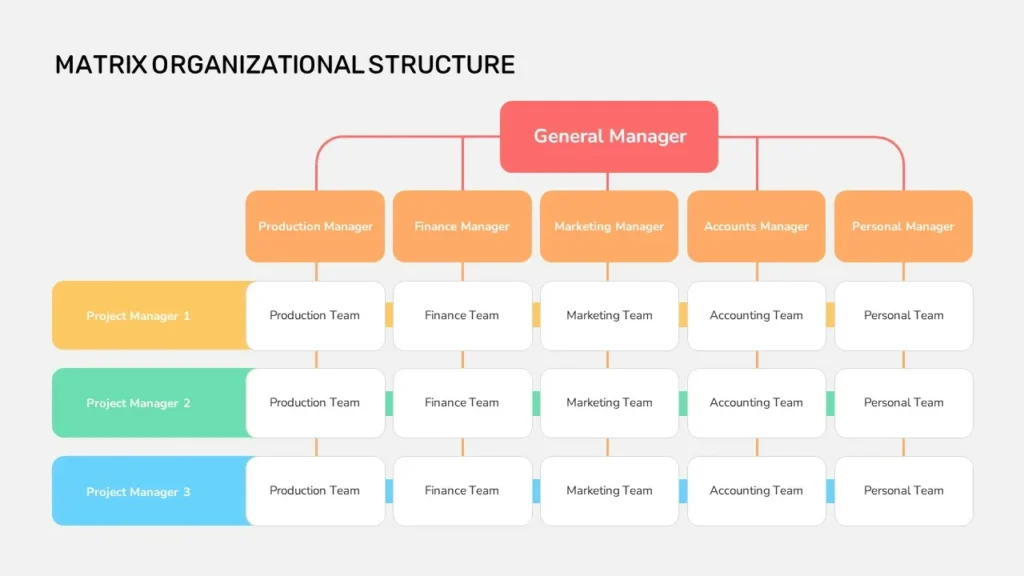
Characteristic:
- Each employee will have two managers: one in charge of function (e.g. marketing, finance) and one in charge of project.
- Operating system both vertically and horizontally.
Advantage:
- Encourage communication and cooperation between departments.
- Use effectively professional skills and business resources.
- Quick adaptation With projects, the market changes constantly.
Limit:
- Likely to happen power conflict between two levels of management.
- Staff under pressure when having to report to two managers at the same time.
- Difficult to assess personal work performance.
Suitable for: Businesses have multiple projects at the same time, especially technology companies, marketing agencies, or construction companies.
4. Geographical organization chart
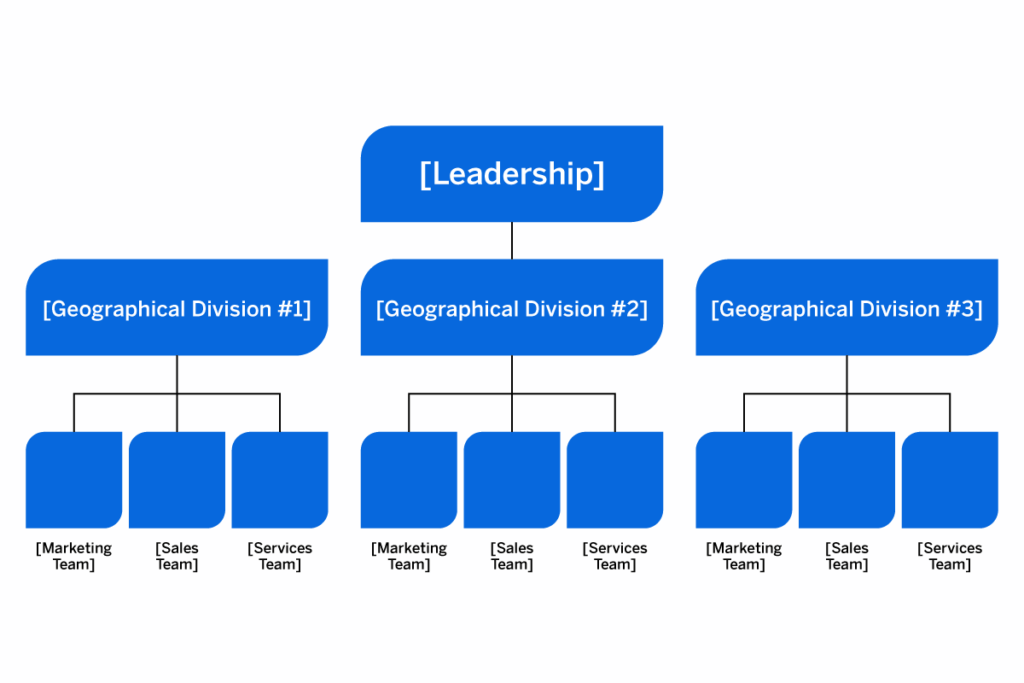
Characteristic:
- Human resources are geographically divided, usually applied to businesses operating in multiple provinces or countries.
- Each area will have independent management apparatus, report to headquarters.
Advantage:
- Good adaptation with local needs and conditions.
- Easy resource planning by region, optimizing logistics and operating costs.
Limit:
- Difficult to monitor and manage centrally, especially for large businesses.
- High management costs due to need leadership teams in multiple locations.
- Likely to happen information delay between branches and the operations center.
Suitable for: Multinational corporations, retail businesses, logistics or manufacturing companies with multiple factories.
5. Flat organization chart
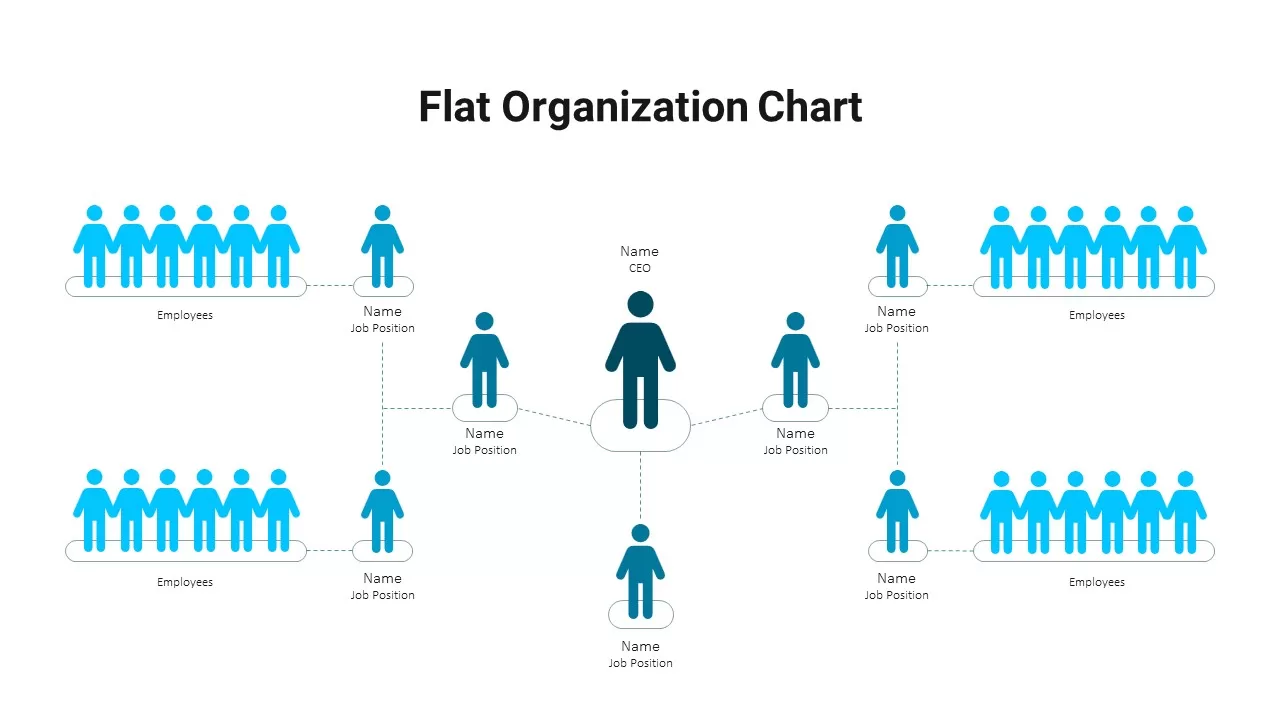
Characteristic:
- Minimize the number of management levels, focus on equality and autonomy of the staff.
- The decision-making process is carried out fast and transparent.
Advantage:
- Streamlining the apparatus, saving operating costs.
- Fast, advanced decision making Flexibility in management.
- Encourage employees proactive and creative, enhance personal responsibility.
Limit:
- Difficult to control as the staff expands.
- Employees can stressed due to large workload
- Likely to happen conflict or power struggle if there are no clear rules.
Suitable for: Startups, creative companies, technology companies are in the phase of testing their business models.
Each organizational chart model has its own direct impact to the allocation budget and expense approval flow.
With Bizzi.vn, businesses can:
- Configure the approval process suitable for each type of organizational chart.
- Ensure every expense has a clear responsible person.
- Effective budget control, no matter what business you operate in strict hierarchical model or flexible flat model.
Sample organizational chart by business type
Each type of business has different management characteristics and operating structures. Designing a suitable organizational chart not only helps clearly define responsibilities, approval flow and power, but also supports businesses in legal compliance and optimizes management efficiency.
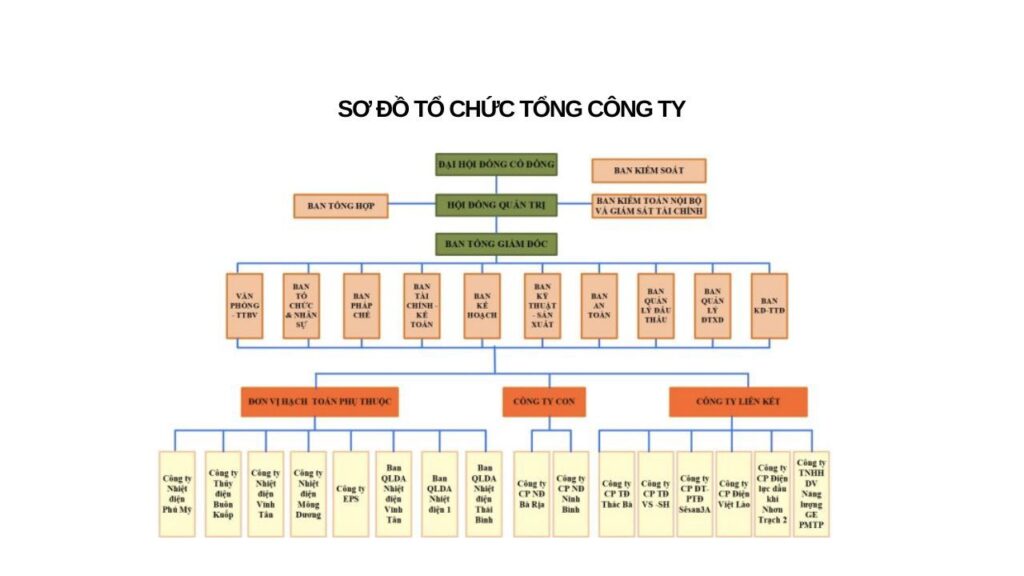
Below are popular organizational chart templates for each type of business in Vietnam.
1. Private Enterprise
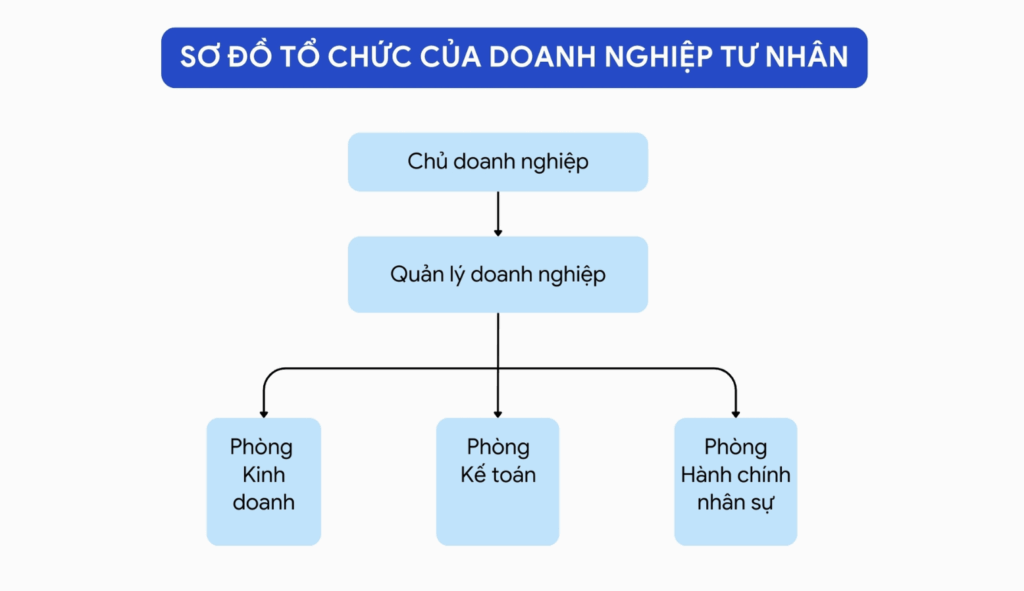
Basic structure:
- Business owner: Full authority to decide on all matters related to operations and finances.
- Business Management: The Director/General Director directly manages daily operations.
- Departments: Business, Accounting, Administration – Human Resources…
Characteristic: Compact structure, easy to manage but depends a lot on the personal capacity of the business owner.
2. Partnership Company
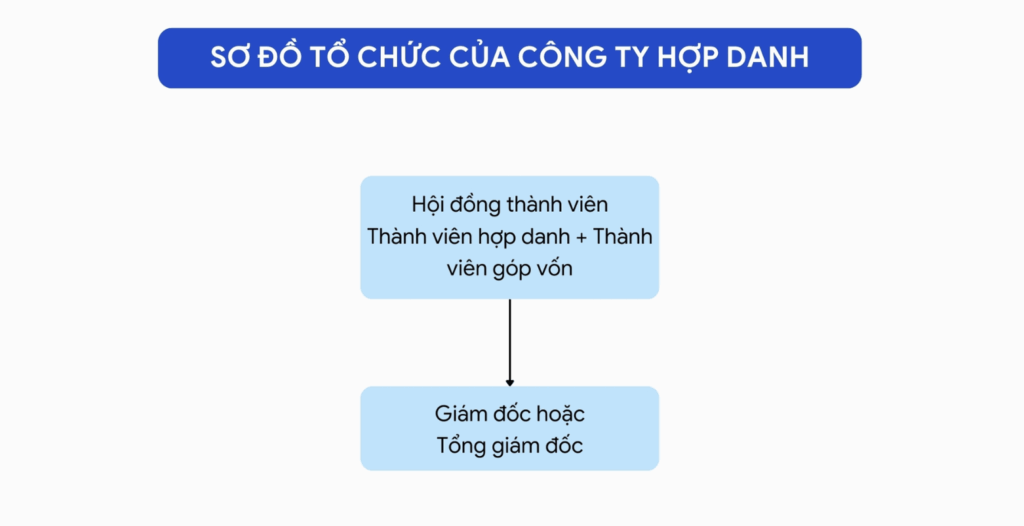
Basic structure:
- Board of members: The highest decision-making body.
- Director/General Director: Run daily business operations.
Characteristic: General partners have unlimited liability for financial obligations, which requires trust and close coordination.
3. Limited Liability Company
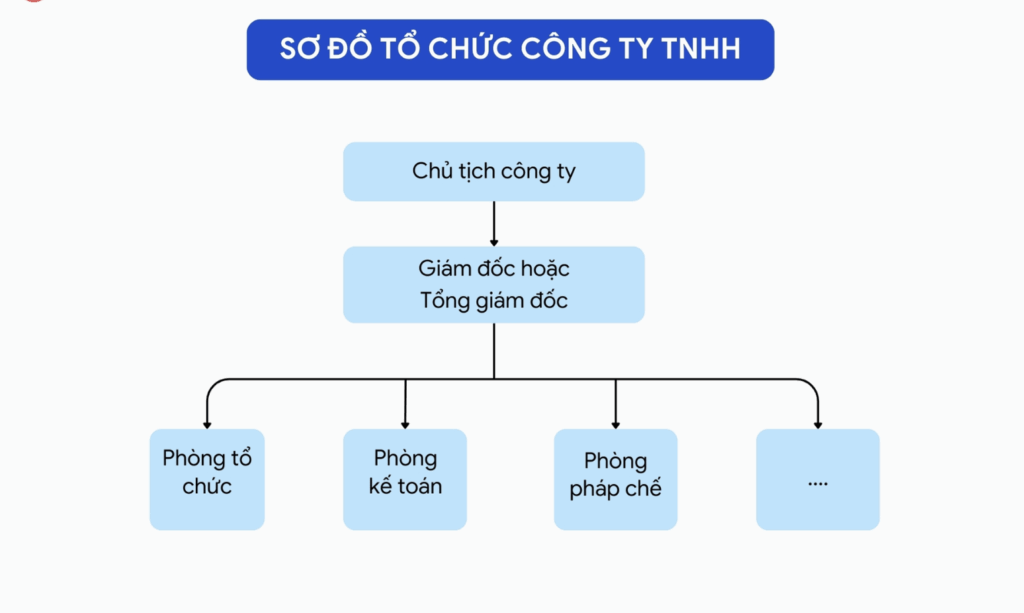
- One member LLC:
- Owner: Can be an individual or an organization.
- Director/General Director: Direct operations.
- Limited liability company with two or more members:
- Board of members: The highest authority.
- Chairman of the Board of Members: Make important decisions.
- Director/General Director: Responsible for day-to-day operations.
Characteristic: Separation of ownership and management, limiting risks for members thanks to limited liability.
4. Joint Stock Company
Sample 1:
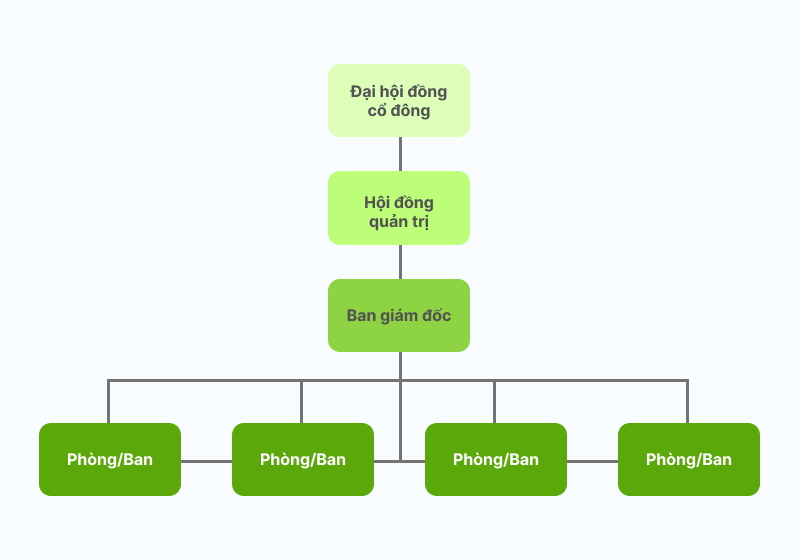
Sample 2:
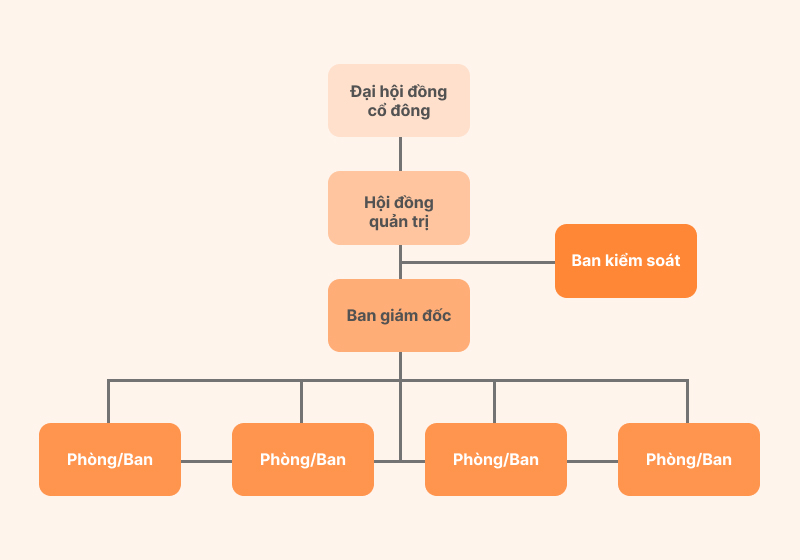
Basic structure:
- General Meeting of Shareholders: Supreme authority, strategic decision.
- Board of Directors (BOD): Manage daily business operations.
- Board of Control: Financial and operational oversight (may or may not be present, depending on size and number of shareholders).
- Director/General Director: Run the company according to the direction of the Board of Directors.
Characteristic: Suitable for large enterprises, strong capital mobilization ability but complex structure, requiring a clear management system.
Regardless of the type of business, manage cash flow, costs and financial compliance always be the top priority.
Bizzi.vn Support financial process automation with solutions such as:
- B-Invoice: Automate electronic invoices.
- Bizzi Expense: Control costs according to budget and approval process.
Free Trial to experience the smart financial management system: https://bizzi.vn/dang-ky-dung-thu
Organizational chart template by industry/field
It depends industry and field of activity, the departmental structure in a business will have significant differences. A properly constructed organizational chart will help effective interdepartmental coordination, ensuring smooth operations and improving productivity.
The section below summarizes typical organizational chart templates for each industry for businesses to refer to and apply.
1. Logistics enterprises:
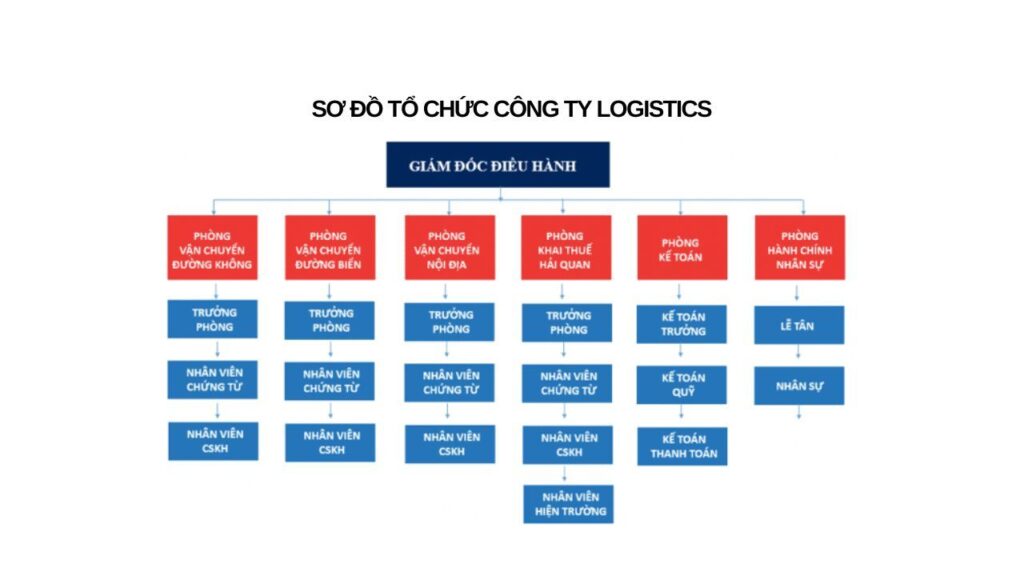
Feature: Focus on warehouse management, transportation and sales systems, requiring tight operating procedures, linking many departments.
Basic departments:
- Leadership
- Administrative Department
- Mining room
- Materials department
- Accounting Department
- Transportation Department
2. Manufacturing Enterprises:
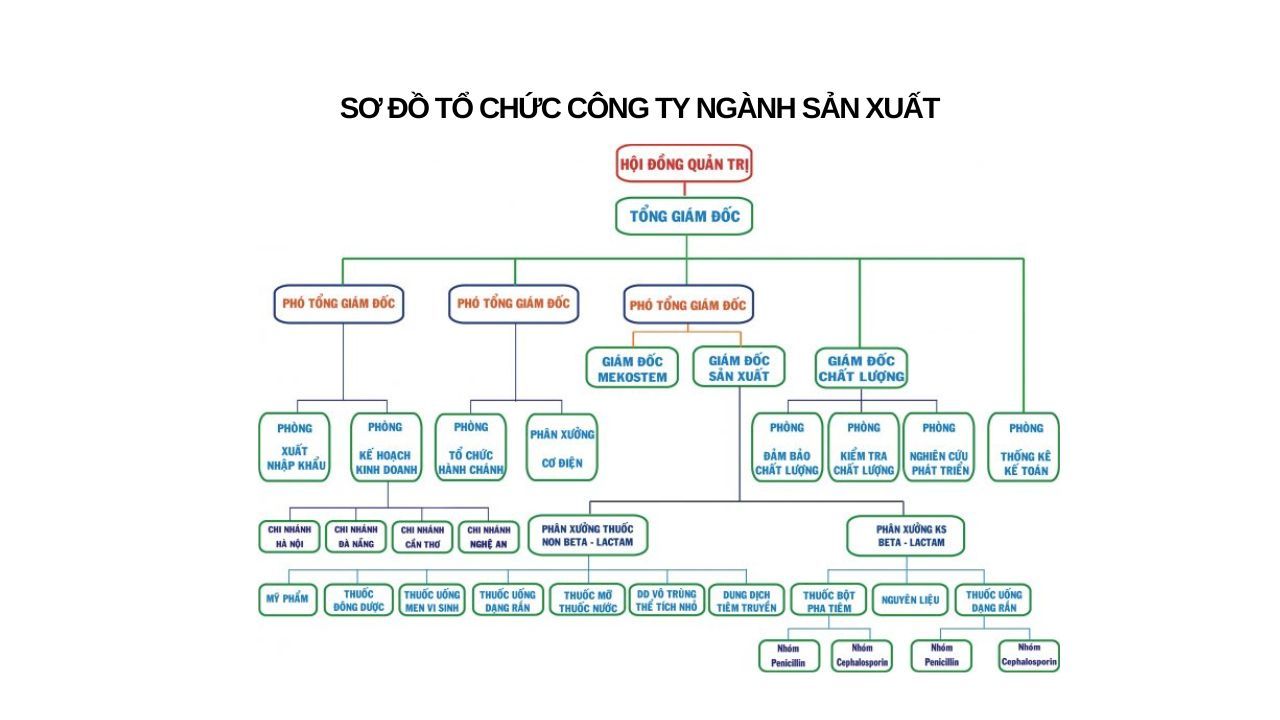
Classify:
- Production - Processing: Focus on manufacturing operations for partners.
- Production - Trade: Produce and sell products directly to the market.
Typical departments:
- Administration - Human Resources
- Accountant
- Sales
- Manufacture
- Quality Control (QC)
- Purchase
- Plan
- R&D and Marketing (for production-commercial model)
3. Construction Enterprises:

Feature: Organizational structures vary depending on project scale and services provided.
Popular departments:
- Administration - Human Resources
- Accountant
- Survey – Design
- Consulting - Supervision
- Sales – Marketing
- Construction
- Purchase
- Experiment – Testing
4. Trading Company:
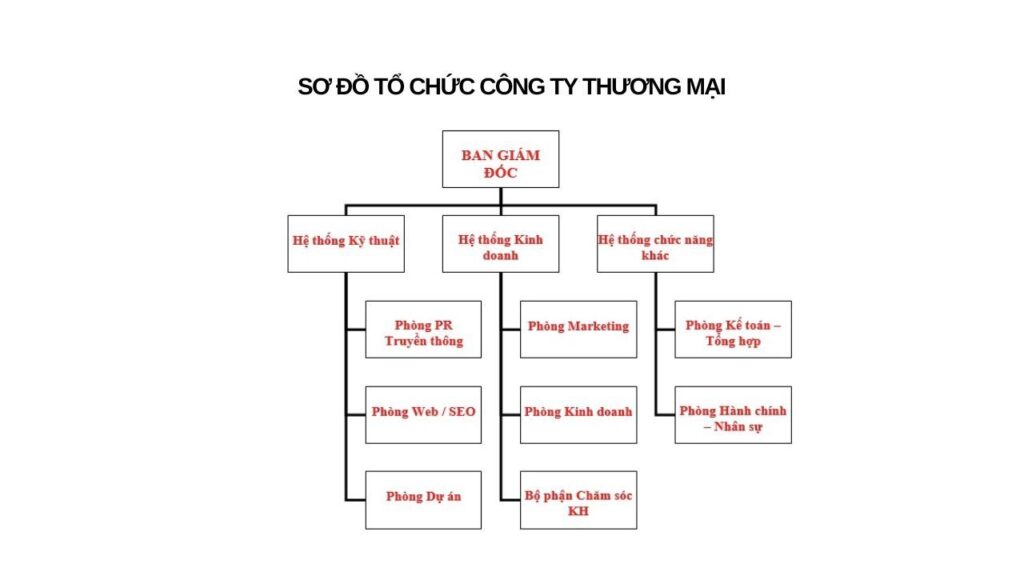
Feature: Focus on business operations, market expansion and supply chain management.
Main departments:
- Board of Directors
- Business system: Marketing, sales, logistics
- Technical system: IT, maintenance, engineering
- Functional parts: Human resources, finance, accounting, administration
5. Chain Business Company
Characteristic: Centralized management of multiple stores or retail outlets requires a synchronized control system.
Typical departments:
- Administration - Human Resources
- Accountant
- Sales
- R&D
- Marketing
- Purchase
- Quality Control (QC)
- Logistics
- Customer care (CSKH)
- Store Expansion
6. Transport Company
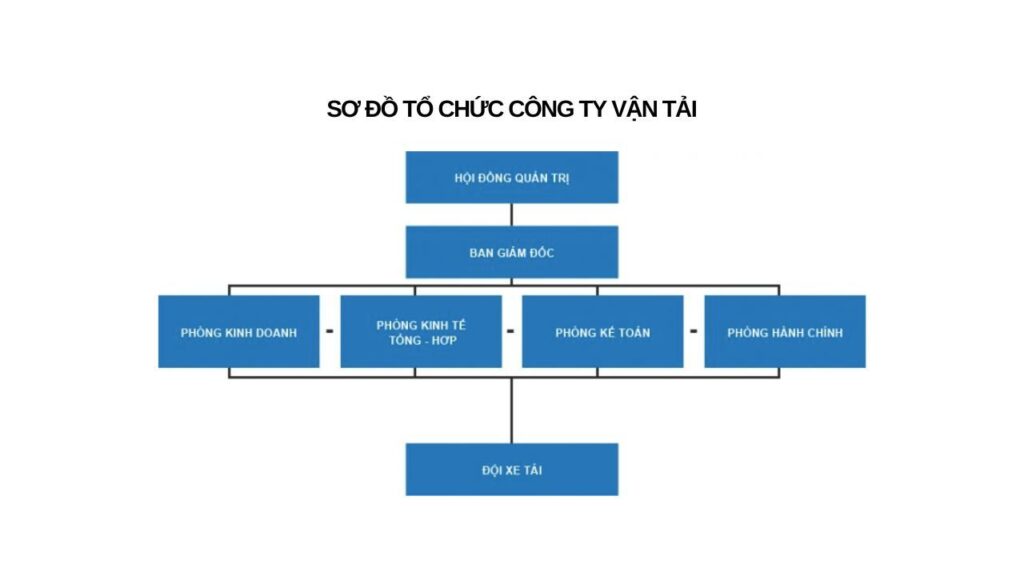
Characteristic: Specializing in providing services transport of goods or passengers, requiring high precision and safety.
Special departments:
- Basic departments (Administration, Accounting, Business…)
- Shipping Department
- Transport service quality control department
7. Travel Company
Characteristic: Providing tourism services, organizing tours, events and customer experiences.
Organizational structure:
- Board of Directors
- Vice president: Executive Management, Human Resources Administration, Business
- Head of Department: Tour Operator, Guide, Administration, Marketing, Finance and Accounting
- Staff: Reception, Tour design, Event organization, Engineering, Tour guide
Although operating in any profession, businesses must manage costs, liabilities and payment procedures in a transparent and efficient manner.
Bizzi.vn provide solutions financial automation, include:
- B-Invoice: Automatically process electronic invoices, minimizing manual errors.
- Bizzi Expense: Control costs according to budget, quick approval.
- ERP Integration: Synchronize data with systems like SAP, Odoo, or existing accounting software.
Try our smart expense management system for free: https://bizzi.vn/dang-ky-dung-thu
Organizational chart for each department
Each department in the enterprise has different roles, tasks and personnel structures. Designing a detailed organizational chart for each department helps effective resource management, identify specific responsibilities for each position and optimize coordination processes between departments.
Below are common organizational charts for each important department in a business:
1. Human Resources Department (HR)
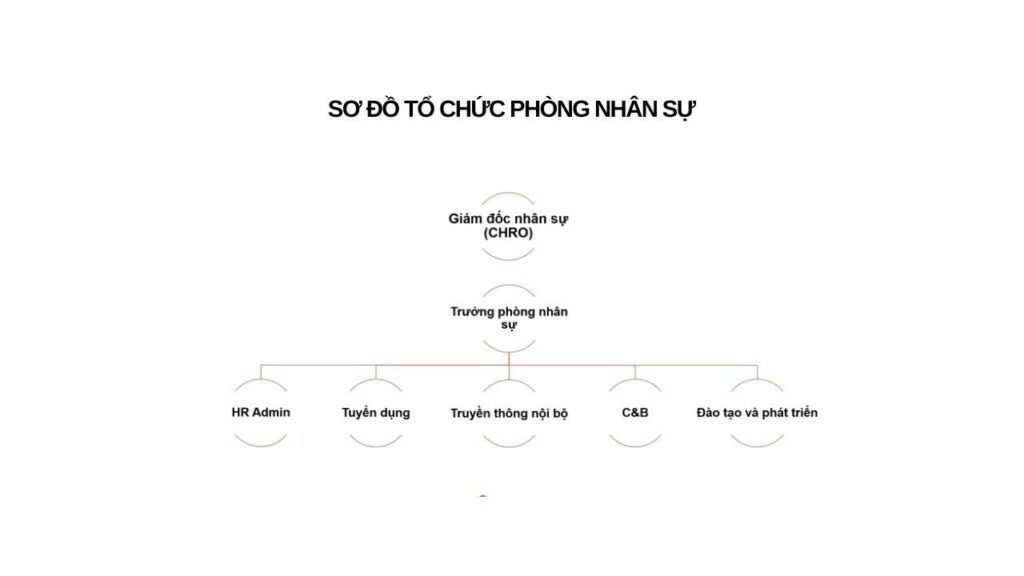
- Role: Take charge of the work recruitment, train, administrative management, payroll management, and employee benefits, and at the same time build corporate culture.
- Typical locations:
- Chief Human Resources Officer (CHRO)
- Head of Human Resources
- HR Admin
- Recruiter
- Internal Communication Specialist
- C&B Specialist (Compensation & Benefits)
- L&D Specialist
The Human Resources Department regularly manages activities related to recruitment, training, benefits and employee travel. The use of Bizzi Travel helps automate business travel booking, travel expense management, and employee benefits, reducing errors and saving time. This frees HR to focus on strategic tasks such as people development and corporate culture management.
2. Accounting Department
- Role: Advise the Board of Directors on financial management, control operating costs, develop and implement financial plans, ensuring compliance with accounting and tax laws.
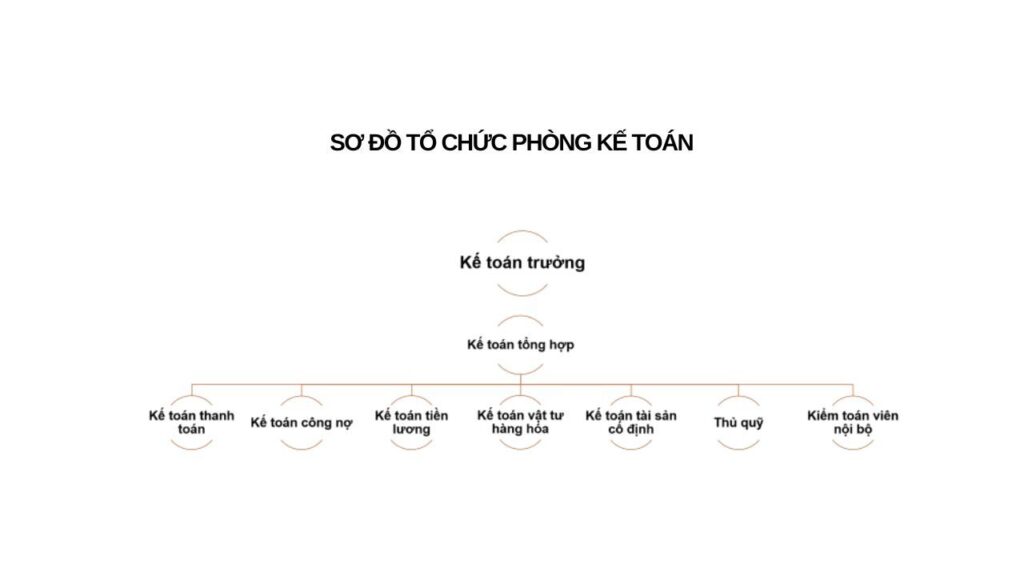
- Typical locations:
- Chief Accountant
- General accounting
- Payment accounting
- Accounts receivable accounting
- Fixed asset accounting
- Accounting for materials and goods
- Payroll accounting
- Treasurer
- Internal auditor
The Accounting Department is the center of financial management, budget planning, cost reporting, and debt management. Positions such as Chief Accountant and General Accountant use Bizzi.vn for an overview of finances, budget tracking by department and project. Bizzi Bot (AI & RPA) supports automatic processing of incoming invoices, PO-GR reconciliation, expense approval and debt reminders, and integrates B-Invoice electronic invoices and corporate credit card management, optimizing the entire cost lifecycle.
3. Sales Department
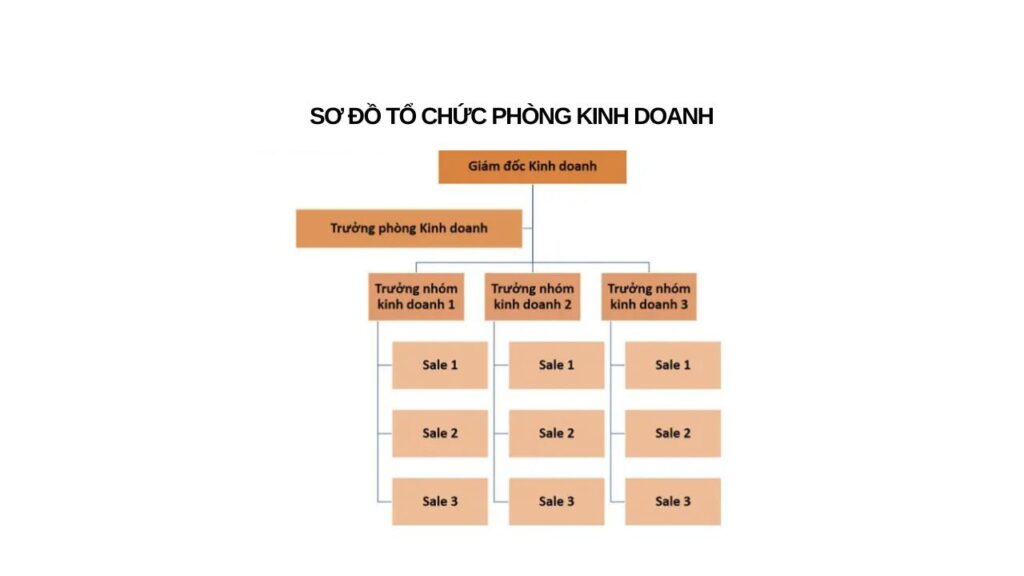
- Role: In charge of revenue, market expansion, product research and customer relationship building.
- Popular models:
- Island model.
- Chain model.
- Group model.
- Typical locations:
Sales Manager- Sales Team Leader
- Sales Executive
- Marketing Specialist
- Customer Service
Sales departments often incur costs related to sales activities, marketing activities, customer care and marketing projects. Use Bizzi Expense, employees can easily submit expense requests, manage travel expenses and comply with company expense policies. This helps the Sales department control costs effectively, while the management has an overview of spending by group, project or region.
4. Marketing Department
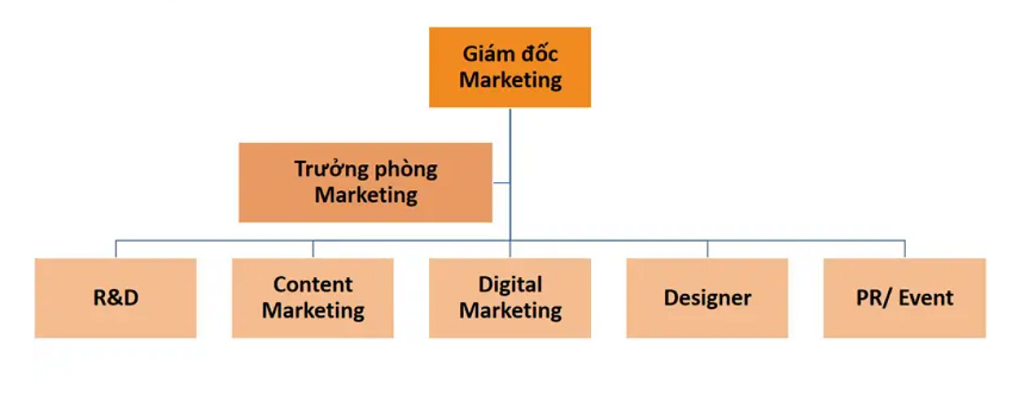
- Role: To be bridge between company and market, in charge of market research, product orientation, brand development and boost sales.
- Typical locations:
- Chief Marketing Officer (CMO)
- Head of Marketing
- Head of sub-departments:
- Market research
- Content Marketing
- Digital Marketing
- Trade Marketing
- PR – Event
- Marketing Specialist
Marketing is the department that connects the company with the market, responsible for advertising, events, market research and brand development. With Bizzi Expense, the Marketing department can automate the expense approval process, manage campaign budgets, travel expenses and event spending. The system ensures all expenses are transparent, approved properly, helping to optimize budgets and report quickly.
5. Head Office

- Role: Center top management, oversee all departments and make strategic decisions.
- Typical locations:
- Board of Directors
- Board of Directors
- Board of Control
- Strategic support departments
The Board of Directors and the Corporation use data from departments to monitor, make decisions and coordinate activities. The application Bizzi.vn Allows to aggregate expenses by department, project or type of expenditure, creating a comprehensive, transparent financial picture and supporting quick decision making. The system helps all expenses to be tightly controlled, in accordance with the organizational chart, while ensuring compliance with corporate financial policies.
4-step guide to building an effective corporate governance chart
A clear corporate governance chart helps the organization run smoothly, defines responsibilities and authorities, and provides a basis for quick decision making. Here is a 4-step guide to building an effective corporate organization chart.
Step 1: Determine the business structure
First of all, businesses need to determine business type such as LLC, Joint Stock Company or Private Enterprise. This helps to determine the highest authority and appropriate management structure.
Next, set up detailed organizational structure, for example: Board of Members, Chairman of the Board, Director/General Director.
Final, List the main departments, including: Planning, R&D, Production, Sales, Marketing, Accounting, Human Resources and Administration. Clearly defining departments helps to allocate responsibilities transparently and easily implement internal processes.
Step 2: List the positions and job roles
At this step, businesses need to classification of positions and ranks from Director, Department Head to Specialist and Staff.
Next, build detailed job descriptions for each position, including: tasks, responsibilities, skills, authority and work relationships. This helps employees understand their roles and supports the performance evaluation process.
Final, describe the relationship between positions, define superior-subordinate relationships and coordination mechanisms in projects, ensuring transparent and effective information flow.
Step 3: Arrange the hierarchy according to the objectives of the organizational chart
Clearly understand hierarchy and relationships between positions is an important step in properly dividing authority and responsibility.
An effective hierarchy helps:
- Decision support fast and clear
- Task assignment and supervision more effective
- Promote cooperation between departments, reduce conflict and increase work performance.
Step 4: Draw an organizational chart and update it regularly
Once the structure and hierarchy have been determined, the business should use software like Drawio, Microsoft Visio or Microsoft Office to draw organizational charts.
Note:
- Use reasonable color, professional fonts and scientific layout to increase visualization.
- Regular updates when there are changes in structure, title, tasks, personnel or business strategy.
The steps to build an organizational chart not only help businesses know who does what and who reports to whom, but also the basis for optimize financial management. With Bizzi.vn, this structure is used to Set up automated spend approval flows, manage departmental and project budgets, simultaneously real-time spending control.
Thanks to this, all expenses are monitored, approved properly and comply with the established governance structure, helping businesses operate more transparently and effectively.
Limitations when using company organization charts and solutions to overcome them
A company organizational chart is an important tool to help businesses define the structure, authority, responsibilities and relationships between departmentsHowever, in reality, especially for large-scale or complex businesses, organizational charts also face many limitations. Identifying these issues helps businesses make appropriate adjustments, improve operational efficiency and decision-making.
1. Diagrams are easily outdated
In organizations with many employees, changing departments or expanding operations, Traditional organizational charts can become obsolete in just a few months.For example, when a new department is created or there is a change in management, if the chart is not updated, employees will not know who is responsible and who reports to whom, leading to confusion and delays in the work process.
Solution:
- Use online tools like Draw.io, Lucidchart, or Microsoft Visio to draw easily editable diagrams.
- Set up the process regular updates (e.g. quarterly or when there are personnel changes) to ensure information is always accurate.
- Attach the diagram to human resource management system to automatically sync when there are updates to the department or job location.
2. Focuses only on authority, not how it is exercised
The traditional organizational chart shows who has what rights but does not reflect how power and responsibility are exercised in practice. A typical example is, two departments have the same approval rights but different management styles – one side is aggressive, one side is slow – this directly affects operational efficiency.
Solution:
- Combine the organizational chart with internal regulations, SOP (Standard Operating Procedure) to demonstrate real-world decision making.
- Use workflow Illustrate approvals, responsibilities, and work processing times.
- Frequent assessment of the effectiveness of power exercise to adjust the allocation of responsibilities, avoiding the situation of "rights on paper but not in reality".
3. Copying models from other businesses
Many businesses, especially startups or new companies, often copy organizational charts from large businesses without considering internal specifics. As a result:
- Rigid structure, inappropriate staff allocation.
- Responsibilities between positions are ambiguous, leading to conflicts or overlap of work.
- Failure to exploit the maximum professional capacity of employees.
Solution:
- Analysis internal strategy and operations, clearly define the necessary departments and roles.
- Draw the current diagram to Identify bottlenecks and redundant layers.
- Customize the diagram based on business goals and size, instead of copying.
4. Too many layers cause information to be delayed
In an effort to maintain tight control, businesses often increase the number of management levels, leading to:
- The approval chain is long and takes a long time.
- Information from staff to the Board of Directors is slow, decisions are delayed.
- Employees lose initiative, easily become bored and stressed at work.
Solution:
- Measurement span-of-control (number of employees a manager directly supervises).
- Decision classification by importance, shortening the approval chain for small decisions.
- Authorization through SOP and work management tools to speed up processing while maintaining overall control.
Organizational charts help businesses decentralize and define responsibilities, but have limitations such as Outdated diagrams, too many layers, or poor transparency of power remains a challenge in practice. Here, Bizzi.vn serves as an effective complementary solution, especially in cost management and financial approvals.
Optimize the approval process
Bizzi takes advantage of the “who does what, who reports to whom” structure to Automate the spend approval flowEven with complex organizational structures, Bizzi ensures:
- Smartly shortened approval chain, reducing decision time.
- Each expense is controlled by role and department, avoiding confusion and errors.
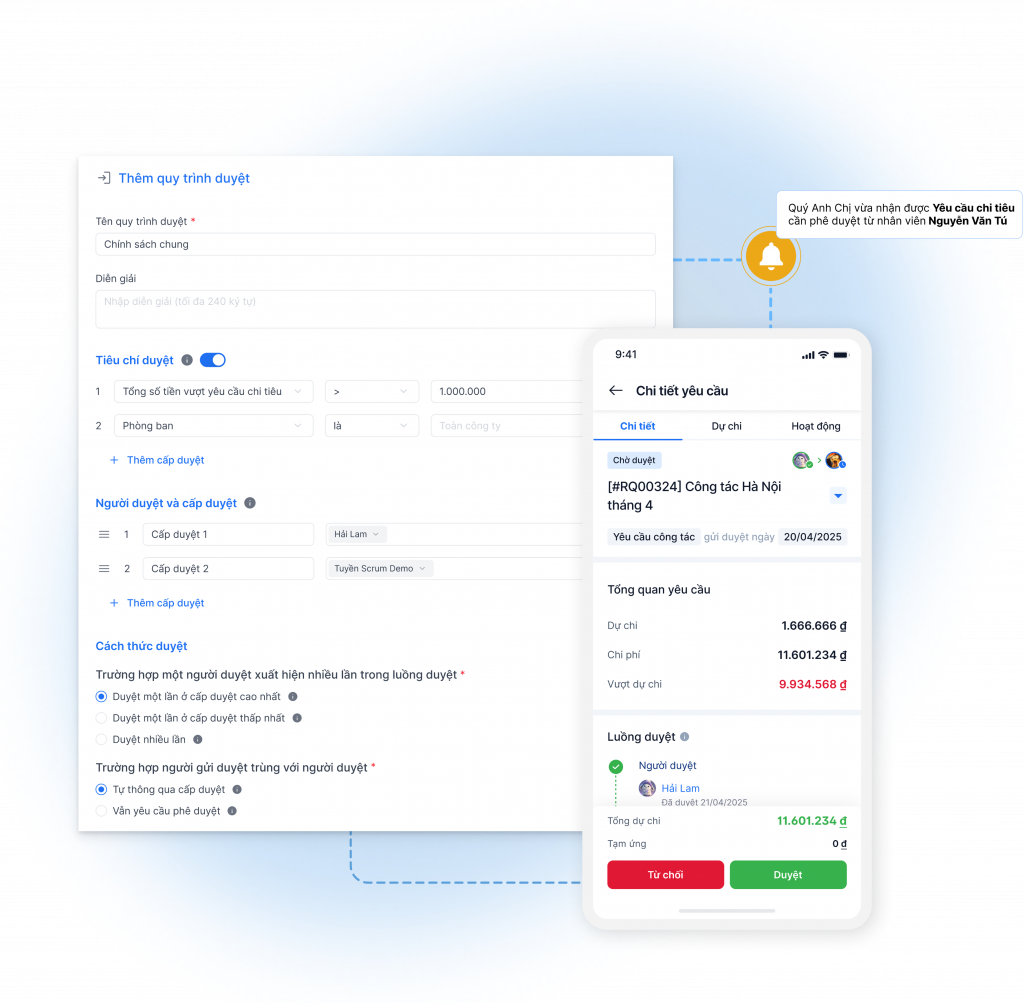
Transparency of financial power
While traditional organizational charts don't reflect actual management styles, Bizzi provides a system for recording all requests, approvals and expenditures, create:
- Clear audit history.
- Visual data helps management monitor how financial power is being exercised.
Reduce administrative burden
Bizzi automates manual tasks like:
- Processing input invoices.
- Manage travel expenses and internal spending.
Human resources from Accounting, HR to Sales and Marketing can focus on strategic work instead of spending time on manual approvals.
Flexible to changes in organizational structure
When businesses adjust their layout, add or remove departments, Bizzi allows:
- Update approval flow according to new diagram.
- Maintain budget control and authority appropriate to each department, project, or management level.
Therefore, the combination of corporate governance diagram and Bizzi.vn not only helps businesses reduce risk, speed up decision making, but also create a transparent and efficient environment for all departments.
Conclude
Corporate governance chart is an indispensable tool, acting as a "compass" help businesses shape sustainable development. When built properly, an organizational chart helps optimize resources, improve work performance and ensure all departments work together smoothly and effectively.
Selecting and building a suitable diagram model there is no general formula. It depends. business type, size, industry, business strategy and needs to be maintained flexibly over time to meet organizational changes. A flexible organizational chart helps businesses adapt easily, make quick decisions and manage work effectively.
When combined with the specialized financial technology solutions, the organizational chart is still most effective. Bizzi.vn is a tool that helps to transform the theoretical structure of the diagram into practical effectiveness: Automate spending approvals, manage budgets by department/project, and ensure transparency of all expenses. Thanks to that, businesses not only operate smoothly but also increase control, reduce risks and improve overall efficiency, contributing to long-term success.
Experience Bizzi.vn now to automate financial processes, optimize budgets and control spending easier than ever. Sign up for a free trial today to get started!
Monitor Bizzi To quickly receive the latest information:
- Facebook: https://www.facebook.com/bizzivietnam
- Linkedin: https://www.linkedin.com/company/bizzi-vietnam/
- Youtube: https://www.youtube.com/@bizzivietnam

